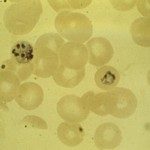Link to Pubmed [PMID] – 2211821
J Cell Biol 1990 Oct; 111(4): 1465-76
Using in situ hybridization, we have investigated the temporal sequence of myosin gene expression in the developing skeletal muscle masses of mouse embryos. The probes used were isoform-specific, 35S-labeled antisense cRNAs to the known sarcomeric myosin heavy chain and myosin alkali light chain gene transcripts. Results showed that both cardiac and skeletal myosin heavy chain and myosin light chain mRNAs were first detected between 9 and 10 d post coitum (p.c.) in the myotomes of the most rostral somites. Myosin transcripts appeared in more caudal somites at later stages in a developmental gradient. The earliest myosin heavy chain transcripts detected code for the embryonic skeletal (MHCemb) and beta-cardiac (MHC beta) isoforms. Perinatal myosin heavy chain (MHCpn) transcripts begin to accumulate at 10.5 d p.c., which is much earlier than previously reported. At this stage, MHCemb is the major MHC transcript. By 12.5 d p.c., MHCpn and MHCemb mRNAs are present to an equal extent, and by 15.5 d p.c. the MHCpn transcript is the major MHC mRNA detected. Cardiac MHC beta transcripts are always present as a minor component. In contrast, the cardiac MLC1A mRNA is initially more abundant than that encoding the skeletal MLC1F isoform. By 12.5 d p.c. the two MLC mRNAs are present at similar levels, and by 15.5 d p.c., MLC1F is the predominant MLC transcript detected. Transcripts for the ventricular/slow (MLC1V) and another fast skeletal myosin light chain (MLC3F) are not detected in skeletal muscle before 15 d p.c., which marks the beginning of the fetal stage of muscle development. This is the first stage at which we can detect differences in expression of myosin genes between developing muscle fibers. We conclude that, during the development of the myotome and body wall muscles, different myosin genes follow independent patterns of activation and accumulation. The data presented are the first detailed study of myosin gene expression at these early stages of skeletal muscle development.

